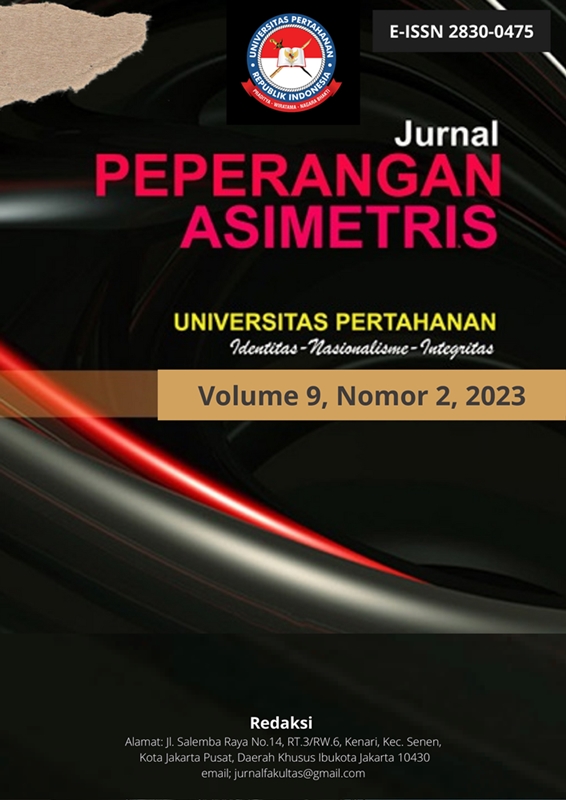PENGAMANAN BIG DATA PADA OPERASI INFORMASI DALAM RANGKA MENINGKATKAN PERTUMBUHAN EKONOMI DIGITAL
DOI:
https://doi.org/10.33172/pa.v9i2.14547Abstract
This paper describes the analysis of security vulnerabilities in the national defense system, especially in the cyber sector, related to the revision of PP 82 of 2012 concerning the Implementation of Electronic Systems and Transactions (PSTE) to PP 71 of 2019. The polemic arising from the revision is the change in the rules for placing data centers or big data infrastructure that originally had to be placed in the territory of the Republic of Indonesia has become a recommendation only. Thus, there are new opportunities for state actors or not state actors to use them as intentions and additional possible ways of acting to attack Indonesian defense. The analysis is carried out by means of a literature study and interviews with relevant stakeholders to obtain the latest data and factual information. From this study, it was found that the security gap due to the change in PP 82 of 2001 to PP 71 of 2019 must be anticipated properly, state sovereignty over the data of its citizens is reduced so that cooperation is needed to anticipate these changes between all stakeholders in Indonesia. Furthermore, the rules for placing data centers can be reviewed so that data problems in cyber warfare can be anticipated properly by the TNIReferences
Alberts, S David (1996), Defensive Information Warfare, National Defennse University, Washington DC.
Anggoro, K. (2011). Perang Asimetris: global, regional dan nasional, in Seminar “Menjawab Tantangan Perkembangan Asymetric Warfare di Kawasan nasional, regional dan internasional”, Indonesia Defense University. Jakarta
Ardiyanti, Handrini (2018), Swafoto: Sebuah Pendekatan Teori Manajemen Privasi Komunikasi”, Fisip UI. Depok.
Aryasa, K. (2015). Big Data: Challenges and Opportunities. In Workshop Big Data Puslitbang Aptika dan IKP, tanggal 19 Mei 2015. Puslitbang Aptika dan IKP.
A.S, Aa Bambang, and Idealisa Fitriana. "Cyberterrorism: suatu Tantangan Komunikasi Asimetris Bagi Ketahanan Nasional." Inter Komunika, vol. 2, no. 1, 2017, pp. 1-15, doi:10.33376/ik.v2i1.12.
Bifet, Alber (2012), Mining Big Data In Real Time, Barcelona, Spain.
Cox, L. Joseph (2006), “Information Operation in Operations Enduring Freedom and Iraqi Freedom-What Went Wrong?”. USA Command and Generall Staff College, Kansas
Denning, E. Dorothy (1998), Information Warfare and Security, ISBN :0201433036, Addison-Wesley.
Esterberg, K.G. (2002), “Qualitative Methods in Social Research” Bostonn, MA. McGrawHill.
Irwansyah dan Winarsih (2020), Proteksi Privasi Big Data dalam Media Sosial, Jurnal Audience :Jurnal Ilmu Komunikasi, Universitas Indonesia.
Jianqing Fan, Fang Han, Han Liu, Challenges of Big Data analysis, National Science Review, Volume 1, Issue 2, June 2014, Pages 293 314, https://doi.org/10.1093/nsr/nwt032
Jonni Mahroza, Priyanto Priyanto, Mhd Halkis, (2022) Asymmetric Diplomacy And Securitization In The South China Sea Vol 11,No,.1, http://ajis.fisip.unand.ac.id/index.php/ajis/article/view/567
Kuner, Christopher, Cate H.Fred, Milliard, Christopher, Stephenson Danker (2012) The Challenge of Big Data for Data Protection, Oxford University.
Miles, M.B., & Michael Huberman, A. (1994) Qualitative Data Analysis (2nd ed) Sage Publication
Moreno Julio, Serrano A. Manuel, and Fernandez-Medina Eduardo,” Main Issues in Big Data Security”, University of Castila-La Mancha, Spain.
Nugroho FP, Abdullah RW, Wulandari S, Hanafi (2019). Keamanan Big Data di Era Digital di Indonesia, STIE “AUB”. Surakarta
Petronio, S. (2002). Boundaries of Privacy: Dialectics of Disclosure. USA: State University of New York
Putra, Ratno Dwi, Supartono, Supartono, & Deni, D. A. R. (2018). Ancaman Siber Dalam Persfektif Pertahanan Negara (Studi Kasus Sistem Pertahanan Semesta). Peperangan Asimetrik, 4(2).
Rohendi, A. (2020). Perlindungan Hukum Big Data. Jurnal Sain Manajemen, 2(2), 1-5. Retrieved from http://ejurnal.ars.ac.id/index.php/jsm/article/view/300
Sofaer, S. (1999). “Qualitatife Methods: What Are They and Why Use Them?” Health Service Research. New York.
S. Madden, "From Databases to Big Data," in IEEE Internet Computing, vol. 16, no. 3, pp. 4-6, May-June 2012, doi: 10.1109/MIC.2012.50.
Suwardana, Hendra (2018). Revolusi Industri 4.0 Berbasis Revolusi Mental. Universitas Ronggolawe, Tuban.
Stacioiu, Alin (2017) The Fourth Revolution Industrial, Industry 4.0, Academia Brancusi, Targu Jiu.
T. A. Berson and D. E. Denning, "Cyberwarfare," in IEEE Security & Privacy, vol. 9, no. 5, pp. 13-15, Sept.-Oct. 2011, doi: 10.1109/MSP.2011.132.
Y. Demchenko, C. de Laat and P. Membrey, "Defining architecture components of the Big Data Ecosystem," 2014 International Conference on Collaboration Technologies and Systems (CTS), Minneapolis, MN, USA, 2014, pp. 104-112, doi: 10.1109/CTS.2014.6867550.
Zhang, Dongpo (2018), “Big Data Security and Privacy Protection,” 8th International Conference on Management and Computer Science (ICMCS 2018), Henan, China.
Downloads
Published
How to Cite
Issue
Section
License
Proposed Policy for Journals That Offer Open Access. Authors who publish with this journal agree to the following terms:
- Authors retain copyright and grant the journal right of first publication with the work simultaneously licensed under a Creative Commons Attribution License that allows others to share the work with an acknowledgment of the work's authorship and initial publication in this journal.
- Authors are able to enter into separate, additional contractual arrangements for the non-exclusive distribution of the journal's published version of the work (e.g., post it to an institutional repository or publish it in a book), with an acknowledgment of its initial publication in this journal.
- Authors are permitted and encouraged to post their work online (e.g., in institutional repositories or on their website) prior to and during the submission process, as it can lead to productive exchanges, as well as earlier and greater citation of published work (See The Effect of Open Access).
Proposed Policy for Journals That Offer Delayed Open Access. Authors who publish with this journal agree to the following terms:
- Authors retain copyright and grant the journal right of first publication, with the work [SPECIFY PERIOD OF TIME] after publication simultaneously licensed under a Creative Commons Attribution License that allows others to share the work with an acknowledgment of the work's authorship and initial publication in this journal.
- Authors are able to enter into separate, additional contractual arrangements for the non-exclusive distribution of the journal's published version of the work (e.g., post it to an institutional repository or publish it in a book), with an acknowledgment of its initial publication in this journal.

